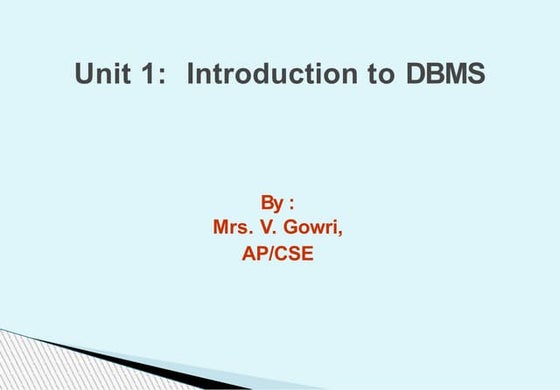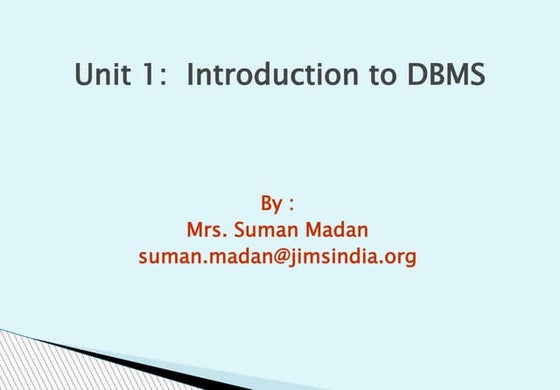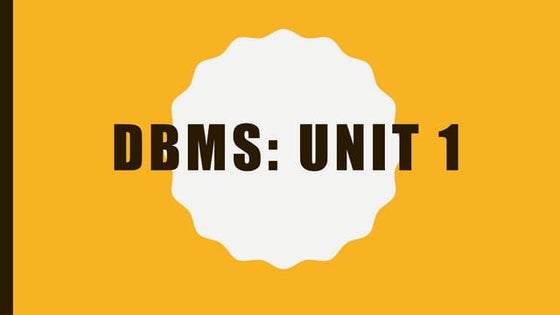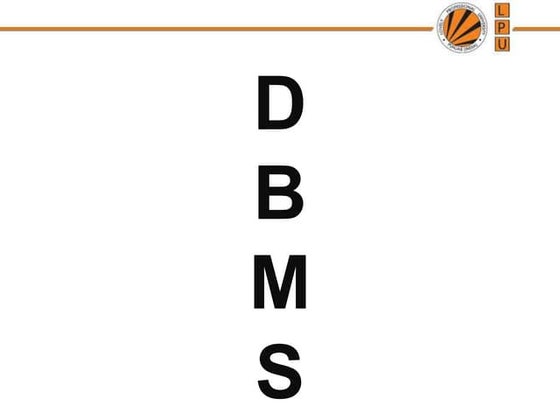database management systems for ug students
- 1. DATABASE MANAGEMENT SYSTEMS B.Sc Computer Science II year ŌĆō IV sem Faculty : Dr.G.Sumalatha 2023-24
- 2. UNIT-1 Introduction Applications Purpose View of Data Database Languages Architecture Database users and Administrators Relational Model Structure of Relational Databases Schema Keys Diagrams Relational Query Languages Relational Operations
- 3. Data: Known facts that can be recorded and have an implicit meaning Database: A collection of related data. Database Management System (DBMS): A software package/ system to facilitate the creation and maintenance of a computerized database 1. INTRODUCTION Applications of DBMS - Banking - Airlines - Universities - Credit card transactions - Tele communication - Finance - Sales - Manufacturing - Human resources -- Electronic Commerce -- Social Networking -- OnLine Analytical Processing (OLAP) Purpose of DBMS: Traditionally, data was organized in file formats. DBMS was a new concept then, and all the research was done to make it overcome the deficiencies in traditional style of data management. The main purpose of the database is to operate a large amount of information by storing, retrieving, and managing data.
- 4. File Organization : Terms and Concepts ŌĆóDatabase: Group of related files ŌĆóFile: Group of records of same type ŌĆóRecord: Group of related fields ŌĆóField: Group of words or a complete number ŌĆóByte: Group of bits that represents a single character ŌĆóBit: Smallest unit of data; binary digit (0,1) Data Hierarchy in a Computer System
- 5. Problems with the Traditional File Environment ŌĆóData redundancy & inconsistency ŌĆóProgram-Data dependence ŌĆóLack of flexibility ŌĆóIntegrity problems ŌĆóPoor security ŌĆóAtomicity problems ŌĆóNo concurrency control Traditional File Processing
- 6. Data Redundancy Data Redundancy means same information is duplicated in several files. This makes data redundancy. Data Inconsistency Data Inconsistency means different copies of the same data are not matching. That means different versions of same basic data are existing. This occurs as the result of update operations that are not updating the same data stored at different places. Example: Address Information of a customer is recorded differently in different files. Difficulty in Accessing Data It is not easy to retrieve information using a conventional file processing system. Convenient and efficient information retrieval is almost impossible using conventional file processing system.
- 7. Data Isolation Data are scattered in various files, and the files may be in different format, writing new application program to retrieve data is difficult. Integrity Problems The data values may need to satisfy some integrity constraints. For example the balance field Value must be grater than 5000. We have to handle this through program code in file processing systems. But in database we can declare the integrity constraints along with definition itself. Independence of data and program Both the database and the user program can be altered independently of each other thus saving time and money which would be required to retain consistency.
- 8. Atomicity Problem It is difficult to ensure atomicity in file processing system. For example transferring $100 from Account A to account B. If a failure occurs during execution there could be situation like $100 is deducted from Account A and not credited in Account B. Concurrent Access anomalies If multiple users are updating the same data simultaneously it will result in inconsistent data state. In file processing system it is very difficult to handle this using program code. This results in concurrent access anomalies. Security Problems Enforcing Security Constraints in file processing system is very difficult as the application programs are added to the system in an ad-hoc manner.
- 9. DBMS and its Advantages ŌĆóA Database Management System is a collection of programs that enables users to create and maintain a database. It is a general purpose software system that facilitates processes of defining, constructing and manipulating databases for various applications. ŌĆóAdvantages of Database approach: ŌĆó Controlling Redundancy ŌĆó Restricting Unauthorized access ŌĆó Providing persistent storage for program objects and data structures ŌĆó Permitting inference and actions using deduction rules ŌĆó Providing multiple user interface ŌĆó Representing complex relationships among data ŌĆó Enforcing integrity constraints and providing backup and recovery
- 10. Basis DBMS Approach File System Approach Meaning DBMS is a collection of data. In DBMS, the user is not required to write the procedures. The file system is a collection of data. In this system, the user has to write the procedures for managing the database. Sharing of data Due to the centralized approach, data sharing is easy. Data is distributed in many files, and it may be of different formats, so it isn't easy to share data. Data Abstraction DBMS gives an abstract view of data that hides the details. The file system provides the detail of the data representation and storage of data. Security and Protection DBMS provides a good protection mechanism. It isn't easy to protect a file under the file system. Recovery Mechanism DBMS provides a crash recovery mechanism, i.e., DBMS protects the user from system failure. The file system doesn't have a crash mechanism, i.e., if the system crashes while entering some data, then the content of the file will be lost. Manipulation Techniques DBMS contains a wide variety of sophisticated techniques to store and retrieve the data. The file system can't efficiently store and retrieve the data. Concurrency Problems DBMS takes care of Concurrent access of data using some form of locking. In the File system, concurrent access has many problems like redirecting the file while deleting some information or updating some information. Where to use Database approach used in large systems which interrelate many files. File system approach used in large systems which interrelate many files. Cost The database system is expensive to design. The file system approach is cheaper to design. Data Redundancy and Inconsistency Due to the centralization of the database, the problems of data redundancy and inconsistency are controlled. In this, the files and application programs are created by different programmers so that there exists a lot of duplication of data which may lead to inconsistency. Structure The database structure is complex to design. The file system approach has a simple structure. Data Independence ŌĆóIn this system, Data Independence exists, and it can be of two types.Logical Data Independence ŌĆóPhysical Data Independence In the File system approach, there exists no Data Independence. Integrity Constraints Integrity Constraints are easy to apply. Integrity Constraints are difficult to implement in file system. Data Models ŌĆóIn the database approach, 3 types of data models exist:Hierarchal data models ŌĆóNetwork data models ŌĆóRelational data models In the file system approach, there is no concept of data models exists. Flexibility Changes are often a necessity to the content of the data stored The flexibility of the system is less as compared to the DBMS
- 11. View of Data External Schema 1 External Schema 2 External Schema n ... Conceptual Schema Physical Schema External Schemas how the data are physically stored what data are stored, what relationships, constraints exist customizations of the conceptual schema to the needs of various classes of users actual data 1st level of abstraction 2nd level of abstraction 3rd level of abstraction
- 12. External view/External schema ŌĆó Different users often need different views of the data. ŌĆó Example: ŌĆó Accountant needs to have access to financial information on a student ŌĆó Head of Department needs access to academic information. ŌĆó Student needs to access marks information. ŌĆó An external schema is a description of part of the DB as seen by an application programmer or a user Logical View/Conceptual Schema ŌĆó Representation of the logical structure of the information content of the DB. ŌĆó Abstracts away from the actual physical storage. ŌĆó It is, in a sense, a composite of all the external schema. Physical/Internal Schema ŌĆó The internal schema describes the data as it is physically stored. ŌĆó For example, ŌĆó record structure ŌĆó types of fields in a record ŌĆó existence of primary and secondary indexes
- 13. Example: University Database ŌĆó Conceptual schema: ŌĆō Students(sid: string, name: string, login: string, age: integer, gpa:real) ŌĆō Courses(cid: string, cname:string, credits:integer) ŌĆō Enrolled(sid:string, cid:string, grade:string) ŌĆó Physical schema: ŌĆō Relations stored as unordered files. ŌĆō Index on first column of Students. ŌĆó External Schema (View): ŌĆō Course_info(cid:string,enrollment:integer) ’é¦The views also provide a security mechanism to prevent users from accessing certain parts of the database For example, tellers in a bank see only that part of the database that has information on customer accounts; they cannot access information about salaries of employees
- 14. Schema & Instance ’é¦ Databases change over time as information is inserted and deleted ’é¦ The collection of information stored in the database at a particular moment is called an instance of the database ’é¦ The overall design of the database is called the database schema ’é¦ The concept of database schemas and instances can be understood by analogy to a program written in a programming language ’é¦ A database schema corresponds to the variable declarations in a program, each variable has a particular value at a given instant ’é¦ The values of the variables in a program at a point in time correspond to an instance of a database schema ’é¦ Database systems have several schemas, partitioned according to the levels of abstraction
- 15. ’é¦ The physical schema describes the database design at the physical level, while the logical schema describes the database design at the logical level ’é¦ A database may also have several schemas at the view level, sometimes called subschemas, that describe different views of the database ’é¦ Programmers develop applications by using the logical schema ’é¦ Physical schema is hidden beneath the logical schema, and can usually be changed easily without affecting application programs ŌĆó Application programs are said to exhibit physical data independence if they do not depend on the physical schema, and thus need not be rewritten if the physical schema changes
- 17. Database Languages ŌĆó Data Definition Language: To specify the database schema. ŌĆó Data Manipulation Language: To express database queries and updates.
- 18. Data Manipulation Language (DML) ’āśLanguage for accessing and manipulating the data organized by the appropriate data model ŌĆó DML also known as query language ’āśTwo classes of languages ŌĆó Procedural ŌĆō user specifies what data is required and how to get those data ŌĆó Declarative (nonprocedural) ŌĆō user specifies what data is required without specifying how to get those data ’āśSQL is the most widely used query language
- 19. ŌĆó A query is a statement requesting the retrieval of information. ŌĆó DML involves information retrieval is called a query language. Data Manipulation Language (DML)
- 20. Data Definition Language (DDL) ’āś Specification notation for defining the database schema Example: create table account ( account_number char(10), branch_name char(10), balance integer) ’āś DDL compiler generates a set of tables stored in a data dictionary ’āś Data dictionary contains metadata (i.e., data about data) ŌĆó Database schema ŌĆó Data storage and definition language ŌĆó Specifies the storage structure and access methods used ŌĆó Integrity constraints ŌĆó Domain constraints ŌĆó Referential integrity (e.g. branch_name must correspond to a valid branch in the branch table)
- 21. Data Dictionary ŌĆó A data dictionary contains a list of all files in the database, the number of records in each file, and the names and types of each field ŌĆó Most database management systems keep the data dictionary hidden from users to prevent them from accidentally destroying its contents. ŌĆó Data dictionaries do not contain any actual data from the database, only bookkeeping information for managing it. ŌĆó Without a data dictionary, however, a database management system cannot access data from the database.
- 22. Architecture
- 23. Storage Manager ŌĆó Storage manager is a program module that provides the interface between the low-level data stored in the database and the application programs and queries submitted to the system. ŌĆó Translates DML statements into low-level file-system commands. ŌĆó The storage manager is responsible to the following tasks: ŌĆó Interaction with the file manager ŌĆó Efficient storing, retrieving and updating of data ŌĆó Controls the placement of data on disk and its movement between disk and main memory. ŌĆó Data structures: ŌĆó Data files: which store the database itself. ŌĆó Data dictionary: stores meta data about the structures of the database. ŌĆó Indices: provide fast access to data items.
- 24. Storage Manager Components: ŌĆó Authorization and integrity manager: ŌĆó Tests for satisfaction of integrity constraints and checks the authority of users to access data. ŌĆó Transaction manager: ŌĆó Consistent state ŌĆó Concurrent transaction executions ŌĆó File manager: ŌĆó Manages the allocation of space on disk storage and the data structures used to represent information stored on disk. ŌĆó Buffer manger: ŌĆó Responsible for fetching the data from disk storage into main memory, and deciding what data to cache in main memory. ŌĆó It enables the database to handle data sizes that are much larger than the size of main memory.
- 25. Query Processor Components: ŌĆó DDL interpreter: interprets DDL statements and records the definitions in the data dictionary. ŌĆó DML compiler: translates DML statements in a query language into an evaluation plan consisting of low-level instructions that the query evaluation engine understands. ŌĆó Translate into any of a number of alternative evaluation plans that all give the same result ŌĆó Query evaluation engine: executes low-level instructions generated by the DML compiler.
- 26. Query Processing 1. Parsing and translation 2.Optimization 3.Evaluation
- 27. Query Processing ŌĆó Alternative ways of evaluating a given query ŌĆó Equivalent expressions ŌĆó Different algorithms for each operation ŌĆó Cost difference between a good and a bad way of evaluating a query can be enormous ŌĆó Need to estimate the cost of operations ŌĆó Depends critically on statistical information about relations which the database must maintain ŌĆó Need to estimate statistics for intermediate results to compute cost of complex expressions
- 28. Data Models ’āś A data model provides a way to describe the design of a database at the physical, logical, and view level. ’āś A collection of tools for describing ŌĆó Data ŌĆó Data relationships ŌĆó Data semantics ŌĆó Data constraints ’āś Relational model ’āś Entity-Relationship data model (mainly for database design) ’āś Object-based data models (Object-oriented and Object-relational) ’āś Semistructured data model (XML) ’āś Other older models: ŌĆó Network model ŌĆó Hierarchical model
- 29. Relational Model ŌĆó Example of tabular data in the relational model Attributes
- 30. A Sample Relational Database
- 31. SQL ŌĆó SQL: Structured Query Language ŌĆó Example: Find the name of the customer with customer-id 192-83-7465 select customer.customer_name from customer where customer.customer_id = ŌĆś192-83-7465ŌĆÖ ŌĆó Example: Find the balances of all accounts held by the customer with customer-id 192-83-7465 select account.balance from depositor, account where depositor.customer_id = ŌĆś192-83-7465ŌĆÖ and depositor.account_number = account.account_number
- 32. The Entity-Relationship Model ŌĆó Models an enterprise as a collection of entities and relationships ŌĆó Entity: a ŌĆ£thingŌĆØ or ŌĆ£objectŌĆØ in the enterprise that is distinguishable from other objects ŌĆó Described by a set of attributes ŌĆó Relationship: an association among several entities ŌĆó Represented diagrammatically by an entity-relationship diagram:
- 33. The Entity-Relationship Model ŌĆó Rectangles: which represent entity sets. ŌĆó Ellipses: which represent attributes. ŌĆó Diamonds: which represent set of relationships among a member from each of several entity sets. ŌĆó Lines: which link attributes to entity sets and entity sets to relationships. ŌĆó Mapping cardinalities: express the number of entities to which another entity can be associated via a relationship set.
- 34. Other Data Models ŌĆó Object-Based data models ’āśObject-oriented data model ŌĆó Object-oriented programming language ’āśObject-relational data model ŌĆó Structured and collection types ŌĆó Object orientation ŌĆó Semistructured data models: ŌĆó Specification of data where individual data items of the same type may have different sets of attributes.
- 35. Hierarchical Model ŌĆó First database systems introduced in the 1960ŌĆÖs were based on the ŌĆ£hierarchical modelŌĆØ ŌĆó This model assumes all data relationships can be structured as hierarchies. ŌĆó Uses a ŌĆ£parentŌĆØŌĆØ and ŌĆ£childŌĆØ relationship where a child can only have one parent. ŌĆó Hierarchical Model still used today on some IBM mainframes such as IBMŌĆÖs IMS system. ŌĆó Need to redesign entire database to change how data is interrelated. ŌĆó Can lead to confusion in relationships of data. ŌĆó Only allows one parent record type. Ratings Salary Compensation Job Assignments Pension Insurance Health Benefits Employer
- 36. Network Model ŌĆó Network Model came about from the Conference on Data Systems Language (CODASYL). ŌĆó Design is based on ŌĆ£data setsŌĆØ ŌĆó Similar to the hierarchical model with sequential access properties. ŌĆó Uses logically related data items to define record types. ŌĆó As data sets are added so is the complexity and confusion. ŌĆó Procedural model of one record processing at a time. ŌĆó Difficult to change data once it is stored ŌĆó Need detailed understanding of the data and how it is stored.
- 37. Database Users Users are differentiated by the way they expect to interact with the system ŌĆó Application programmers ŌĆō interact with system through DML calls ŌĆó Sophisticated users ŌĆō interact with the system without writing the programs. ŌĆó form requests in a database query language ŌĆó Specialized users ŌĆō write specialized database applications that do not fit into the traditional data processing framework ŌĆó Na├»ve users ŌĆō invoke one of the permanent application programs that have been written previously ŌĆó Examples, people accessing database over the web, bank tellers, clerical staff ŌĆó Read reports generated from the database.
- 38. Database Administrator ŌĆó Coordinates all the activities of the database system; the database administrator has a good understanding of the enterpriseŌĆÖs information resources and needs. ŌĆó Database administrator's duties include: ŌĆó Schema definition ŌĆó Storage structure and access method definition ŌĆó Schema and physical organization modification ŌĆó Granting user authority to access the database ŌĆó Specifying integrity constraints ŌĆó Monitoring performance and responding to changes in requirements
- 39. Transaction Management ŌĆó A transaction is a collection of operations that performs a single logical function in a database application ŌĆó Transaction-management component ensures that the database remains in a consistent (correct) state despite system failures (e.g., power failures and operating system crashes) and transaction failures. ŌĆó Concurrency-control manager controls the interaction among the concurrent transactions, to ensure the consistency of the database.
- 40. Transaction Management ACID Properties ŌĆó Key concept is a transaction: a sequence of database actions (reads/writes). ŌĆó A transaction is a collection of operations that performs a single logical function in a database application ŌĆó DBMS ensures atomicity (all-or-nothing property) even if system crashes in the middle of a execution ŌĆó Each transaction, executed completely, must take the DB between consistent states or must not run at all. ŌĆó DBMS ensures that concurrent transactions appear to run in isolation. ŌĆó DBMS ensures durability of committed execution even if system crashes.























































































